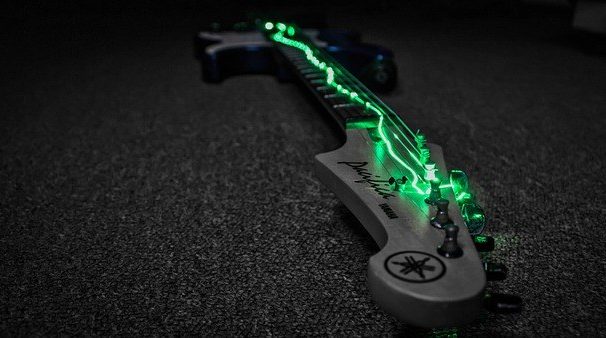
Power chords on guitar can give you a surprisingly big sound for such small shapes. You’ve heard power chords a million times, and you’ll be pleased with how easy they are to play.
What are power chords on guitar?
Power chords are musical dyads that consist of the root note and 5th scale degree note. Technically power chords are not actually chords at all since they only contain two notes instead of at least three. Since power chords do not contain the 3rd scale degree, they can neither be said to be major nor minor.
What are power chords used for?
Mention power chords on guitar to most musicians and they will likely immediately think of heavy metal, punk, and other aggressive forms of electric rock and roll.
Even though power chords consist of just two notes, they can sound huge. When played on an electric guitar treated with distortion, compression, overdrive, and other effects, power chords are, well, powerful.
But power chords are useful beyond these heavy genres too. In fact, you could apply them in the right situation in virtually any genre. They’ve been used in everything from classical to blues to folk.
And they aren’t just for electric guitar either. There may be times when you can use them to great effect even on acoustic guitar.
How to play power chords on guitar
Power chords are actually exceptionally easy to play on guitar. You have a few different shapes to choose from, so let’s take a look at them. Since these chords consist of just the root and the 5th degree, it’s critical for you to be able to find these two notes in any key.
To find the relationship between the root and 5th, read
How to master notes on the guitar fretboard through relationships
Low E string rooted power chords
Power chords based off of the Low E string might be the most popular form of all. These are very easy to play. They also contain the most power because they use the two fattest strings on the guitar.
To play this form, first find the root note of the chord you want to play on the Low E string. For example, to play a G power chord, find the root note G at fret 3 of the Low E string. Play that note with your pointer.
Now that you have the root, you just need to add the 5th degree. The notes of the G scale are:
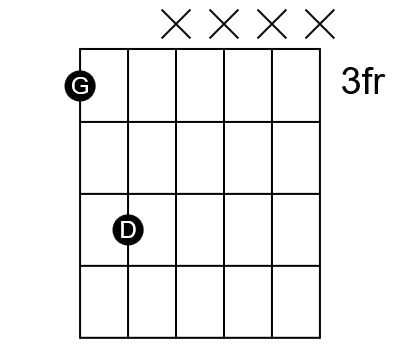
G, A, B, C, D, E, F#
From that you can see that D is the 5th of the scale. So, to make a G power chord you need to add a D note along with your G root note. Use any of the techniques you know to locate the D note.
I find the easiest way to think about it as the 5 is always one string and two frets higher than the root note. So, find the D note you need at fret 5 of the A string. Play that note with your ring finger.
Strum these two strings together and let them ring. Or, use muting techniques to partially mute the strings for kind of a “chugging” sound. We’ll have to talk about string muting in another article.
This same form works for creating any other power chord. If the next chord is an A, move this shape up two frets so your first finger plays A and your second plays E.
If your next chord is a Cm, play this shape at the 8th fret. Remember, power chords are neither major nor minor, so the same shape works regardless of which the chord progression calls for.
A string rooted power chords
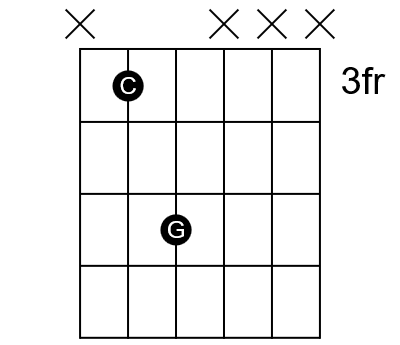
As if playing power chords on guitar with the root on the Low E wasn’t easy enough, that same shape works exactly the same on the A string. Just find the root note on the A string and play it with your first finger.
Then, move up one string and two frets to play the 5th. For instance, say you want to play a C power chord. The notes of the C major scale are:
C, D, E, F, G, A, B
So the 5th degree of C is the note G. With your pointer at fret 3 of the A string to play the C note, move up one string and two frets to play fret 5 of the D string with your ring finger. That’s the note G and you then have your power chord.
D string rooted power chords

Although it’s not quite so common as power chords rooted on the E and A strings, you can use the same shape again to play power chords rooted on the D string.
If we stick to fret 3 as we have so far, you’d play the F at fret 3 of the D string. Then you’d add the C at fret 5 of the G string.
You now have an F power chord rooted on the D string.
Just like with the power chords rooted on the two lower strings, you can move this shape up and down the D and G strings to find any chord you need. The D string note is the root note of the chord.
Inverted power chords
While the shape we just discussed may be the most popular shape, it’s not the only possibility. You can also create inverted power chords on guitar.
Remember, the 5th scale degree note is always one string lower on the same fret as the root note. So, an alternate way to play a C power chord is to use this inversion.
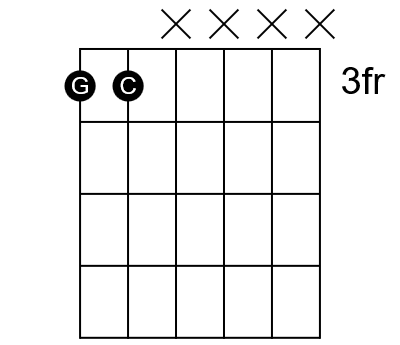
Find the C note at fret 3 of the A string. The 5th degree of the C scale is G, and you can play the G note on the Low E string also at fret 3.
You could choose a few different ways to make this chord shape. You might use your middle finger on the E string and your ring finger on the A string. Or, you might choose to bar across both strings with your pointer.
Find the most comfortable way for you. But keep in mind that the fingering you use could change depending upon the situation. One time you might bar it. The next you might use two different fingers.
Honestly, the form is so easy that you’ll quickly get to a point where you no longer think about the fingering and you just use what feels natural in the moment.
Adding octave notes for even more power
Of course, the guitar offers tons of options and flexibility. You can add even more power to your power chords by combining the two shapes we’ve learned so far and introducing octave notes to fill the chord out.
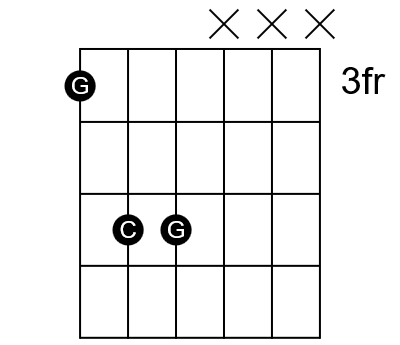
Say you want to play a G power chord. You know you can use the first position shape at fret 3 of the E string. And, you also know you could use the inversion shape at fret 5 of the A and D strings.
Well, if you really want to go big, combine the two shapes. Play fret 3 of the Low E with your pointer. Play fret 5 of the A string with your ring finger. And finally, play fret 5 of the D string with your pinky.
This gives you a G on the E string, a C on the A string, and another G one octave higher on the D string.
You can, of course, use the same shape with your pointer on the A string. This combined power chord shape provides the biggest sound of all.
Other power chords on guitar
These positions we’ve talked about here are the most commonly used power chord shapes. But they are by no means the only possibilities. Technically any time you have the root and the 5th together, you have a power chord.
So, the A at fret 5 of the High E string plus the D at fret 3 of the B string played together gives you an A power chord. Likewise, the C at fret 5 of the G string plus the G at fret 8 of the B string give you a C power chord.
They might not feel so much like chords because these high strings provide a thin sound, but technically they are every bit power chords as their fat-string brothers.
Power chords in a chord chart
On a chord chart, power chords are usually identified by the letter of the root note followed by the numeral 5. So, a G power chord would appear on a chart as G5.
Make sure not to get confused between G5, which means a power chord, and G+5 which is sometimes the form used for augmented chords on chord charts.
Don’t know what an augmented chord is?
In some cases you might also see power chords on charts written with a (no 3) designation. So a G power chord might appear on a chart as G5 or as G(no 3). The (no 3) form seems far less common.
Conclusion
Power chords are used in virtually any genre of music. However, they are especially prominent in aggressive electric-guitar-driven genres like heavy metal and punk.
Power chords on guitar are exceptionally easy to play since they consist of just two notes, the root and the 5th degree. There are two major forms used most often, and these can be combined for a very big, powerful sound.
While power chords might not technically actually be chords since they have only two notes, they are widely used and extremely useful.
